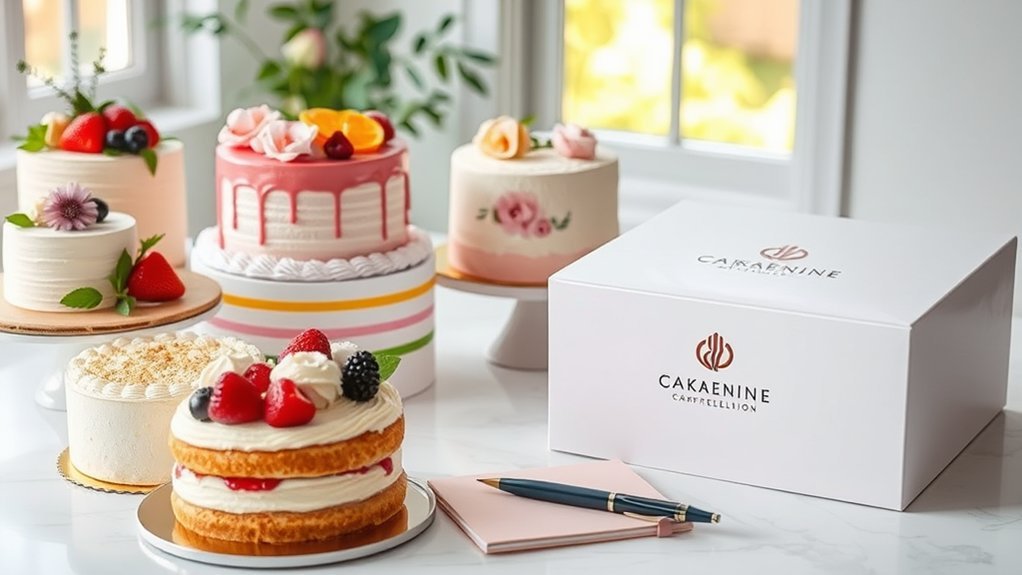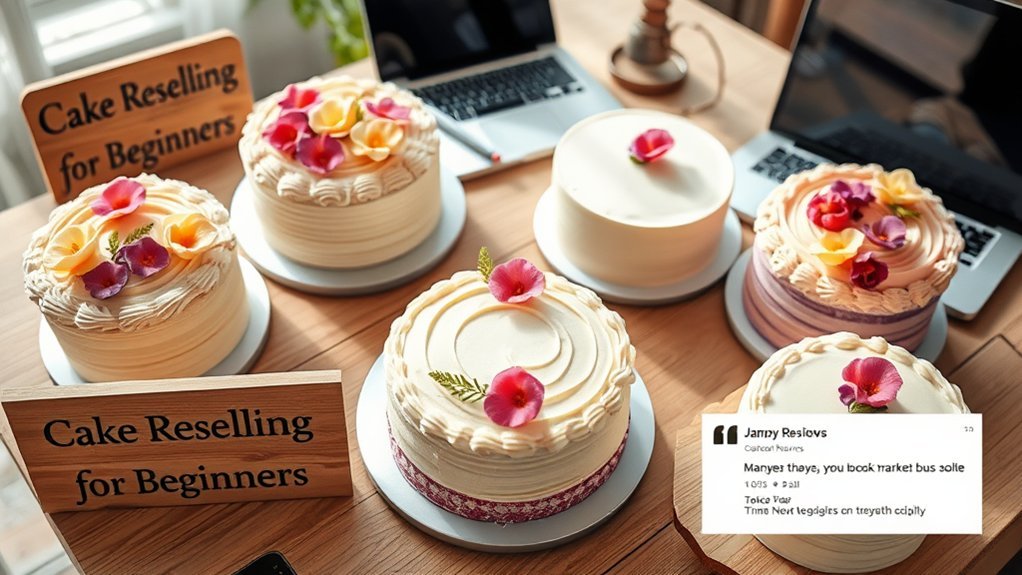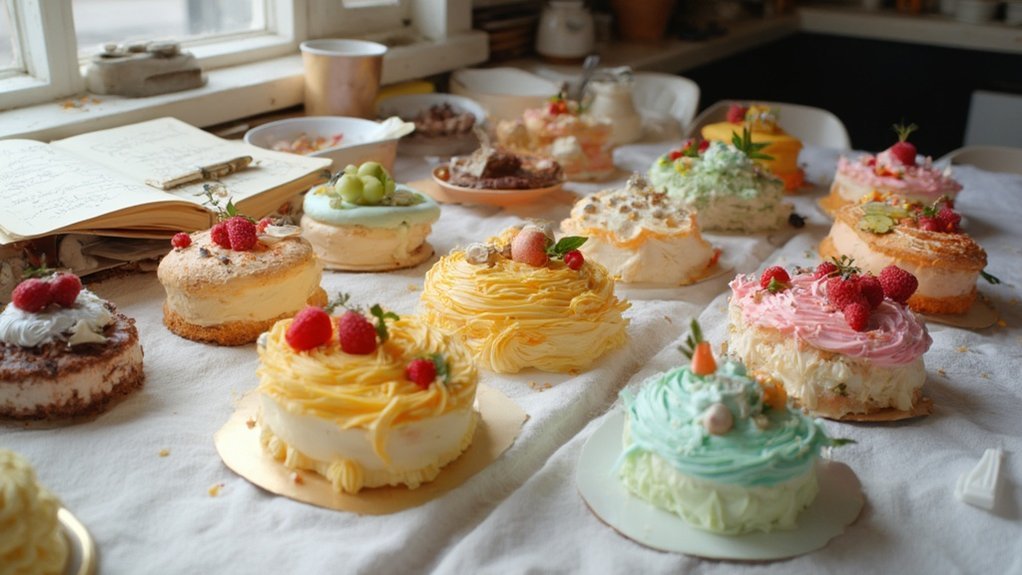Cake Reselling for Beginners: A Step-by-Step Guide
To launch your cake reselling business, begin by defining your niche—think about artisan cakes or catering to dietary requirements like gluten-free options. Set up your home bakery, ensuring you comply with health regulations and invest in reliable equipment. Create a strong brand identity with a memorable name and logo, and price your cakes fairly. Utilise social media and local events to promote your cakes and build customer relationships. There's plenty more to learn about effectively growing and sustaining your business!
Key Takeaways
- Identify your niche by concentrating on specific cake types, like artisan or dietary options, to attract your ideal customers.
- Research local market demand and what competitors offer to gauge pricing and flavour preferences.
- Comply with local health regulations and obtain the necessary licences for home-based cake reselling.
- Create a strong brand identity with a unique name, logo, and consistent messaging to foster customer loyalty.
- Use social media to showcase your cakes, interact with customers, and promote special offers or events.
Identifying Your Niche and Market Research

How can you carve out your unique space in the busy world of baking? Start with identifying your niche. Consider focusing on specific products like artisan cakes or catering to dietary needs, such as gluten-free options. You might also specialise in event baking, targeting weddings or corporate functions to boost your market appeal. Additionally, you could emphasize unique flavor combinations to attract a broader audience.
Next, conduct market research—look at your competitors to find gaps and understand your target audience's preferences. Assess local demand for particular baked goods and keep an eye on current trends to ensure your offerings align with what consumers want. Gathering feedback through surveys can help you refine your products. Additionally, consider sourcing certified organic ingredients to appeal to health-conscious consumers and enhance the quality of your cakes.
Setting Up Your Home Bakery

As you embark on setting up your home bakery, it's essential to create a workspace that meets legal standards and sparks your creativity.
Start by checking your kitchen against local health department regulations and securing the necessary licences and permits. This safeguards both your business and personal assets.
Next, think about your equipment. Investing in robust mixers or ovens can significantly boost your baking efficiency. Additionally, understanding local laws regarding home-based food sales is crucial for ensuring compliance.
Keep your space organised by separating personal and business items, and ensure proper ventilation is in place.
Lastly, make sure you have sufficient storage for ingredients and packaging. A well-organised and compliant kitchen not only simplifies your baking process but also enhances the quality of your products, paving the way for your success.
Developing Your Brand Identity

Developing your brand identity is akin to perfecting a cake recipe—each element is crucial in creating something remarkable.
To distinguish yourself, concentrate on these essential aspects:
- Unique Selling Proposition (USP): Clearly state what makes your cakes stand out.
- Brand Name: Select a catchy name that connects with your audience.
- Visual Branding: Design a consistent logo and colour scheme that showcases your style.
- Brand Storytelling: Share your journey and values to forge an emotional bond with customers. Effective branding enhances emotional connections with customers. Incorporating organic ingredients into your cakes can further emphasize your commitment to quality and health.
- Consistent Messaging: Use a warm and friendly tone across all platforms.
Pricing Your Products and Sales Strategies

Setting the right prices for your cakes is crucial for your business's success. Start by calculating your total costs, including ingredients, labour, and overheads.
Then, research local competitors to ensure your prices are competitive while still meeting your profit targets. You might consider cost-plus pricing for simplicity or value-based pricing to highlight the unique aspects of your cakes.
Transparency in pricing is also important; let customers know what goes into your creations to build trust. Additionally, consider sourcing organic ingredients to appeal to health-conscious consumers and justify premium pricing.
Lastly, be prepared to adjust your prices based on demand or seasonal trends to optimise sales. Balancing these strategies will help you thrive in the market!
Marketing Your Cakes and Managing Customer Relations

To effectively market your cakes and nurture strong customer relationships, understanding your audience is essential. Start by pinpointing your target demographics and analysing your competitors to find your unique selling point.
Here are some key strategies to consider:
- Use social media platforms like Instagram and Facebook to showcase eye-catching images of your cakes.
- Create a content strategy that features behind-the-scenes insights and customer testimonials.
- Organise sampling events and competitions to engage with your local community.
- Set aside at least 10% of your sales for targeted marketing efforts.
- Introduce a loyalty programme to reward repeat customers.
Frequently Asked Questions
What Are the Legal Requirements for Home-Based Bakeries?
To set up your home-based bakery in the UK, you must meet specific legal requirements and health regulations. Start by registering your business with the local council and obtaining the necessary permits. Ensure you comply with food safety standards, such as proper hygiene practices and labelling. For example, if you plan to sell cakes, make sure you understand allergen regulations. Staying on the right side of the law will help your bakery thrive.
How Do I Handle Food Allergies in My Cakes?
To manage food allergies in your cakes, focus on clear allergy labelling and ingredient substitutions. Always highlight potential allergens, such as nuts, gluten, or dairy, on your packaging. Consider using alternatives like almond milk instead of regular milk or gluten-free flour if someone is gluten intolerant. This way, you can ensure your cakes are safe and enjoyable for everyone.
Can I Sell Cakes at Local Farmers' Markets?
If you're considering selling cakes at local farmers' markets, start by checking the local regulations. As market trends change, make sure your cakes stand out. Compliance is essential; be creative while adhering to the rules to boost your chances of success in this lively community.
What Packaging Options Ensure My Cakes Stay Fresh?
To keep your cakes fresh, opt for cake boxes with freshness seals. These boxes protect against moisture and air, ensuring your cakes remain moist and appealing. Plus, they look great, making your cakes even more tempting for customers.
How Do I Manage Multiple Orders Efficiently?
To manage multiple orders effectively, simplify order tracking and ensure clear communication with customers. Utilise software to keep tabs on orders, prioritise tasks, and keep clients informed. For instance, you could set up automated updates for order progress, which helps maintain a smooth workflow and boosts overall satisfaction.
Conclusion
In the exciting world of cake reselling, you're not just selling cakes; you're creating experiences that delight taste buds and evoke cherished memories. The global bakery market is set to exceed £450 billion by 2025, showing the vast opportunities available to you. By following this guide, you'll find your niche, build a memorable brand, and connect with customers eager for your unique creations. So, let your baking journey begin!







